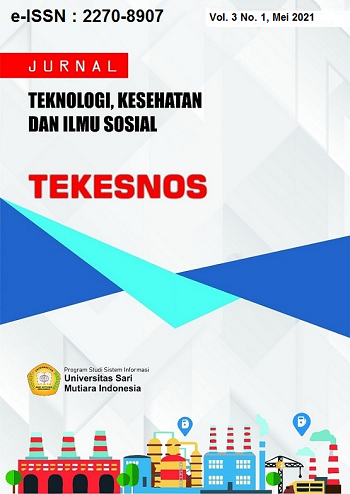UJI DAYA ANTI BAKTERI DARI EKSTRAK ETANOL DAUN BANGUN-BANGUN (Coleus ambonicius L.) TERHADAP BAKTERI PENYEBAB JERAWAT (Propionibacterium acnes)
Keywords:
Coleus ambonicius. L, antibacterial, Propionibacterium acnesAbstract
Background: Leaves are a plant that is widely used and widely cultivated throughout Indonesia, and has the potential as a traditional medicinal plant that is beneficial for the health of the body. Bangun-bangun leaves have been investigated and are known to contain compounds that are thought to have antibacterial activity, namely flavonoids, and tannins. The bacteria used to test the antibacterial ability of the leaves was Propionibacterium acnes. Objective: The purpose of this study was to determine the antibacterial activity of the ethanolic extract of the leaves of Bangun-bangun against Propionibacterium acnes bacteria. Method: The process of making extracts of the leaves of Bangun-bangun using the maceration method with 96% ethanol as a solvent. The macerate was evaporated until a thick extract of the leaves was obtained. The simplicial powder was characterized and screened for phytochemicals. The concentration treatment groups used were 1%, 2%, and 3%. The test was carried out by the agar diffusion method against the test bacteria using a paper backer, the results were observed in the form of a zone of inhibition and the value of the Minimum Inhibitory Concentration (MIC) was determined. Results: Results Characterization of simplicial powder, including water content, water-soluble extract content, ethanol soluble extract content, total ash content, and acid insoluble ash content were as follows: 7.99%, 24,24%, 24,02%,5,82,%, and 1.24%. The results of the screening of Simplicial powder were positive for containing alkaloids, flavonoids, glycosides, saponins, tannins, and steroids/triterpenoids. The results showed that the ethanol extract of the leaves of Bangun-bangun had an antibacterial activity with the MIC value of the ethanolic extract of the leaves of Bangun-bangun against Propionibacterium acnes at concentrations of 1%, 2%, and 3%, respectively. Conclusion: The ethanolic extract of the leaves of Bangun-bangun has very strong activity as an antibacterial.
Downloads
References
Abbdasah, M., Sumiwi, S.A., dan Hendrayana, J. (2009). Formulasi Ekstrak Daun Sukun (Artocarpus altilis (Parkins.) Fosberg) dengan Basis Gel sebagai Antiinflamasi. Jurnal Farmasi Indonesia. 4(4): 199-209.
Barel, A.O., Paye, M., dan Maibach, H.I. (2001). Handbook of CosmeticScience and Techonolgy. New York: Marcel Dekker Inc. Hal. 779.
Dalimartha, Setiawan. (2004). Atlas Tumbuhan Obat Indonesia. Jakarta: Pustaka Bunda. Hal. 25 26.
Djajadisastra, J., Mun’im, A., dan Dessy, N.P. (2007). Formulasi Gel Topikal
dari Ekstrak Nerii folium dalam Sediaan Antijerawat. Jurnal Farmasi Indonesia. 4(4): 210-216.
Depkes RI. (1989). Materia Medika Indonesia. Jilid V. Jakarta: Depkes RI.
Hal. 151-154.
Depkes RI. (1995). Farmakope Indonesia. Edisi IV. Jakarta: Depkes RI. Hal.
, 854-855.
Difco Laboratories. (1977). Difco Manual of Dehydrated Culture Media and
Reagents for Microbiology and Clinical Laboratory Procedures. Ninth edition. Detroit Michigan: Difco Laboratories. Hal. 32, 64.
Ditjen POM. (1979). Farmakope Indonesia. Edisi III. Jakarta : Depkes RI.
Hal.9.
Ditjen POM. (1985). Formularium Kosmetika Indonesia. Jakarta: Departemen
Kesehatan RI. Hal. 32-36.
Draelos, Z.D., dan Thaman, L.A. (2006). Cosmetic Formulation of Skin Care
Products. New York: Taylor and Francis Group. Hal. 191.
Fransworth, N.R. (1996). Biologycal and Phytochemical Screening of Plants.
Journal of Pharmaceutical Science. 55(3): 262-264.
Harborne, J.B. (1995). Metode Fitokimia Penuntun Cara Modern
MenganalisisTumbuhan. Edisi III. Bandung: ITB Press. Hal.102.
Karlina, C.Y., Ibrahim, M., dan Trimulyono, G. (2013). Aktivitas Antibakteri
Ekstrak Herba Krokot (Portulaca oleracea L.) terhadap Staphylococcus aureus dan Escherichia coli. Lenterabio. 2(1): 87-93
WHO,1998.Quality control methods for medicinal plant material. World Health Organization Genewa.Halaman 25-28.
Marselia,S., Wibowo, M.A., Arreneuz,S.2015. Aktivitas antibakteri ekstrak daun soma (Ploiarium alternifolium Melch) terhadap Propionibacterium acne .JKK .4(4):74-80.













